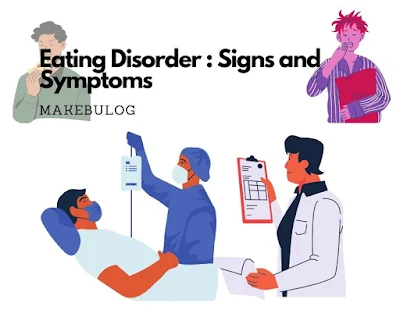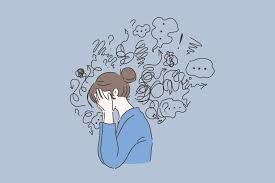Today's youth are aware of their look and personality. they seem becoming very conscious about the body. You must have seen many such people who are irrational about their food or they eat it very thoughtfully. it is very much possible that these people could be suffering & this is a signs and symptoms of eating disorder, even many children falling under the age group of 13-17 years are suffering from an eating disorder. these patients may need immediate help, or else some of these can become life-threatening. You can help them like a friend or a loved one if you see any signs and symptoms. that are visible in people who suffer from an eating disorder.
So now we will see their signs and symptoms :
- The person may experience emergent weight loss or weight gain.
- They become more conscious of their weight and body shape.
- A person may like to eat alone.
- The person may be found checking themselves in the mirror more often than usual.
- The person may be seen either having smaller portions of food or skipping meals.
- The person may start chewing their food enormously.
- They may be seen taking laxatives after meals deliberately.
- The person may present with extreme mood swings.
- They may start exercising vigorously.
- They may suddenly put themselves under an extreme diet that excludes sugar, carbohydrates, and dairy.
- They may induce vomiting after meals to avoid weight gain.
- Women with an eating disorder may face menstrual irregularities.
- The person may complain of being dizzy and tired due to a lack of energy in the body.
- You may see callus formation across the top of finger joints due to induced vomiting.
- These people may have discoloration of teeth because of frequent vomiting.
- due to a lack of nutrients in the body, it may present with dry skin, thin hair, and brittle nails.
What are the Common Types of Eating Disorders:
These three types of eating disorders, that are very common:
- Binge Eating Disorder: people suffering from this can be seen eating large amounts of food to the point of discomfort. in this kind of disorder people shame and distress allied with their feeding habits. this disorder appears, especially in the United States. it can develop in adolescence and early adulthood or later on. individuals typically eat unusually large amounts of food rapidly in relatively short periods and feeling a lack of control during binges. they have a feeling of guilt, distress, disgust, such as shame when thinking about binge-eating behavior. people with this disorder often have obese and overweight. this may increase their risk of heart disease, stroke, type 2 diabetes.
- Anorexia Nervosa: it may be seen reducing their diet and being calorie-conscious. they may present with a dramatic weight loss. it affects women more than men. people with anorexia view themselves as overweight. they avoid eating a few types of food, and harshly restrict their calories. such individuals may have difficulty eating in public. and show a strong desire to control their environment, limiting their ability to be natural. after they eat, they depurate using activities like vomiting, taking exercising, or laxatives, or diuretics extremely. anorexia can be very damaging to the body. individuals living with it then may experience infertility, thinning of their bones, brittle hair and nails, and the growth of a layer of fine hair all over their body. in some cases, anorexia can result in brain, heart, multi-organ failure, and death.
- Bulimia Nervosa: bulimia tends to develop during adolescence and early adulthood. it appears to be less common among men than women. this a life-threatening eating disorder. an affected person may take to practices like self-induced vomiting after eating a lot of food at once to purge themselves. during a binge, the person usually feels that they cannot stop eating or control how much they are eating. common purging behaviors include forced vomiting, fasting, enemas, diuretics, laxatives, and excessive exercise. their symptoms are, a fear of gaining weight, despite having a normal weight, self-esteem overly influenced by body shape and weight, binge eating with a feeling of lack of control, inappropriate purging behaviors to prevent weight gain. side effects of bulimia; swollen salivary glands, an inflamed and sore throat, tooth decay, acid reflux, worn tooth enamel, severe dehydration, and hormonal disturbances, irritation of the gut. bulimia can create an imbalance in levels of electrolytes. such as calcium, sodium, and potassium. This can cause a heart attack or a stroke. people fear gaining weight despite being at a normal weight in this.
It is some other else disorders that are included in too :
- Pica: In this eating disorder involves eating things that are not considered food. Individuals with this crave non-food substances, such as paper, hair, dirt, ice, soil, chalk, soap, pebbles, cloth, wool, cornstarch, laundry detergent. this disorder is oftentimes observed in children, pregnant women, and people with mental disabilities. individuals with pica perhaps at an increased risk of infections, poisoning, nutritional deficiencies, and intestine injuries. pica may be fatal. the eating of non-food substances must not be normal in some cultures and religions.
- Rumination disorder: It is a newly recognized eating disorder. a person pours food they have previously chewed. and swallowed, re-chews it. and then either re-swallows it or spits it out. this disorder can develop during childhood and adulthood. rumination disorder can result in weight loss and severe malnutrition that can be death. it can affect people at all stages of life.
- Avoidant/restrictive food intake disorder ( ARFID): It is a new name for an old disorder. it was known as a "feeding disorder of infancy and early childhood." ARFID generally develops during infancy or early childhood. it can go through into adulthood. it is equally common among men and women. individuals experience disturbed eating either due to a lack of interest in eating. distaste for certain smells, textures, temperatures, colors, tastes. avoidance of food access that prevents the person from eating enough nutrients and calories. individuals have eating habits that interfere with social functions like eating with others, get poor development for age and height, and weight loss. they depend on tube feeding or supplements and have nutrition deficiencies. ARFID goes besides normal behaviors such that picky eating or lower food intake in older adults. it causes people to undereat.
- Purging disorder: individuals have often use purging behaviors, such that laxatives, vomiting, diuretics, exorbitant exercising to control their weight or shape.
- Night eating syndrome: individuals with this syndrome frequently eat enormously. they often awakening after sleep.
- Other specified feeding or eating disorder (OSFED): This is orthorexia. it is recognized as a separate eating disorder by the current DSM. the affected person eliminates the food group. they fearing that they are unhealthy. this can lead to emotional distress, severe weight loss, denutrition, and difficulty eating outside the home. The OSFED includes all eating disorders.
Eating disorders are mental health conditions. it requires treatment. if you have an eating disorder, tell someone, ask for help from healthcare. & please go and meet with the doctor.












0 Comments